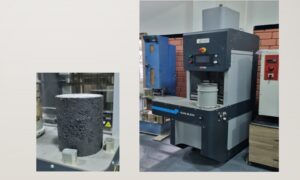NBRRI Gyratory Compactor: Advanced Compaction for Asphalt Mix Design
 NBRRI Gyratory Compactor
NBRRI Gyratory Compactor is an essential machine used by the
Nigerian Building and Road Research Institute (NBRRI) to simulate the compaction of asphalt mixtures under field conditions. This device enables engineers to design and evaluate asphalt mixes by compacting samples in a manner that replicates actual traffic loads and stresses. The compactor applies controlled pressure and gyration to create test specimens that closely mimic in-field conditions, providing accurate and consistent results. This makes it invaluable for mix design, quality control, and research and development in road construction.
Function
The primary function of the NBRRI Gyratory Compactor is:
- To compact asphalt samples by simulating the pressure and rotation they would experience under real traffic, producing specimens that can be analyzed for density, stability, and performance.
The Gyratory Compactor creates high-quality specimens that offer reliable data on the durability, strength, and longevity of asphalt mixes, critical for designing pavements that withstand traffic loads over time.
Applications
The NBRRI Gyratory Compactor has several applications in asphalt testing and pavement design:
- Asphalt Mix Design Optimization:
By simulating field compaction, the compactor helps engineers refine asphalt mix designs to achieve the optimal balance of density and air voids, which enhances durability and performance.
- Quality Control and Assurance:
The compactor is used in quality control to ensure that asphalt mixtures produced in the field match the specifications set during design, maintaining consistency and performance in road construction.
- Evaluation of Compaction Characteristics:
Testing the compaction properties of different asphalt mixtures helps engineers understand how each mix responds to traffic loads, leading to improved material selection for specific traffic conditions.
- Research and Development of New Mixtures:
The device supports research into innovative asphalt materials, such as recycled asphalt, polymers, or fibers, by providing a controlled way to compact and test new formulations for strength and durability.
How It Works
The NBRRI Gyratory Compactor operates through a system of controlled pressure and gyration that compresses asphalt samples to simulate real-life pavement conditions:
- Sample Preparation and Placement:
A prepared asphalt mixture sample is placed in a cylindrical mold, and the mold is positioned within the compactor’s chamber. The sample weight, dimensions, and temperature are standardized based on the test requirements.
- Application of Vertical Pressure:
The compactor applies a constant vertical pressure to the sample, simulating the compressive forces exerted by traffic loads. The pressure level is adjustable based on the specific test parameters.
- Controlled Gyration Movement:
While pressure is applied, the machine gyrates the sample at a fixed angle, replicating the shearing action caused by vehicle tires. This movement distributes the asphalt particles evenly and compacts them similarly to what occurs during real pavement compaction.
- Monitoring and Data Collection:
Sensors within the machine monitor the sample’s density and air void content in real-time. The compactor’s software collects data on the compaction characteristics, providing essential information on density, voids, and stability.
- Final Specimen Extraction and Analysis:
After compaction, the specimen is extracted from the mold and prepared for further testing, such as stability and flow testing, to assess its performance characteristics.
The Gyratory Compactor’s ability to produce accurate, reproducible specimens that mimic field compaction conditions is critical for evaluating the quality and durability of asphalt mixtures.
Benefits of the NBRRI Gyratory Compactor
- Simulates Real-World Conditions: The gyratory compactor replicates the stresses and shear experienced by asphalt in the field, providing more accurate insights into how the material will perform under actual traffic loads.
- Improves Asphalt Mix Design: By compacting samples to field-like densities, the compactor helps engineers optimize asphalt mix design for long-term durability and resistance to rutting and other forms of deformation.
- Ensures Quality Control: Using the compactor in quality control ensures that field-produced asphalt meets design specifications, enhancing the longevity and safety of pavements.
- Supports Innovation in Asphalt Materials: The compactor is essential for testing advanced materials, including sustainable and modified asphalt mixtures, aiding in the development of high-performance pavements.
In summary, the
NBRRI Gyratory Compactor is a pivotal tool in asphalt mix design and quality control. By simulating field compaction conditions, it produces specimens that provide valuable data on an asphalt mix’s density, stability, and durability. This data enables engineers to design and select asphalt mixes that offer superior performance under traffic loads, supporting NBRRI’s commitment to building durable, high-quality road infrastructure.
 NBRRI Gyratory Compactor is an essential machine used by the Nigerian Building and Road Research Institute (NBRRI) to simulate the compaction of asphalt mixtures under field conditions. This device enables engineers to design and evaluate asphalt mixes by compacting samples in a manner that replicates actual traffic loads and stresses. The compactor applies controlled pressure and gyration to create test specimens that closely mimic in-field conditions, providing accurate and consistent results. This makes it invaluable for mix design, quality control, and research and development in road construction.
NBRRI Gyratory Compactor is an essential machine used by the Nigerian Building and Road Research Institute (NBRRI) to simulate the compaction of asphalt mixtures under field conditions. This device enables engineers to design and evaluate asphalt mixes by compacting samples in a manner that replicates actual traffic loads and stresses. The compactor applies controlled pressure and gyration to create test specimens that closely mimic in-field conditions, providing accurate and consistent results. This makes it invaluable for mix design, quality control, and research and development in road construction.
